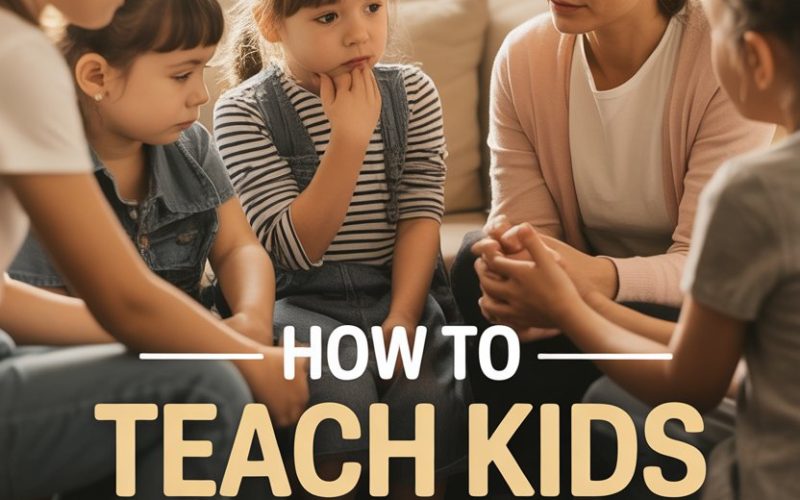Ever try prying a feeling out of a child, only to get the emotional equivalent of a shrug and a grunt? Welcome to the club.
Growing up is hard enough without having to put words to the wild mess of feelings inside. But giving kids the words to name their feelings isn’t just a cute milestone—it’s a real superpower.
Here’s how to help them build it, even if your own emotional vocabulary sometimes stalls out at “tired” and “hungry.”
Why Feelings Words Matter for Kids
Sure, it’s tempting to assume your child will just “pick it up as they go.”
But studies show that children who can accurately name their emotions are better at managing them, less likely to lash out, and even more successful in their relationships—now and later (Journal of School Psychology).
Basically, kids who know the word “frustrated” are less likely to scream blue murder when their biscuit breaks. That’s a win-win.
Start Simple and Small
Children aren’t born reciting the Oxford Dictionary of Emotions. For little ones, stick to the basics: happy, sad, angry, scared. These are the emotional equivalents of learning colours or animal sounds.
Make it a game. At dinner, ask everyone to pick a feeling from the day. If your toddler says “spaghetti,” go with it and gently guide them to “hungry” or “excited.” It all counts.
Model Naming Your Own Feelings
Ever muttered “I’m fine” through gritted teeth? Kids are expert detectives—especially when it comes to catching us fibbing.
Make a habit of saying your feelings out loud: “I’m feeling a bit overwhelmed because there’s a lot to do.” It’s amazing what a little honesty can do.
Even better, show them it’s okay to have tricky feelings. “I feel disappointed we can’t go to the park. Want to help me think of something else fun?”
No one expects you to be a Zen master. Just aim for “slightly less mysterious than a brick wall.”
Books Are Secret Weapons
Too tired to whip up a feelings flashcard game? No problem. Books about emotions do the heavy lifting for you.
Kids see characters naming and handling their feelings, and suddenly, words like “nervous” and “proud” aren’t just in your nagging arsenal—they’re out in the wild, too.
A few to try:
The Colour Monster by Anna Llenas (for talking about mixed-up feelings)
Ruby Finds a Worry by Tom Percival (helpful for anxious types)
My Many Coloured Days by Dr. Seuss (because who can resist?)
The best part: bedtime story becomes a stealthy emotional lesson. Genius.
Name Feelings You See—Everywhere
Running errands? Watching TV? There’s always an emotion to spot. “That boy on the bus looks frustrated. Maybe he wanted a turn.” “Peppa Pig looks proud she built that block tower.”
This isn’t about psychoanalyzing every dog walker on the street.
Just sprinkle it in, and your child will start to notice and label feelings everywhere, like a mini anthropologist—without the oversized glasses.
Use Visuals When Words Aren’t Enough
Not every child is ready for a TED talk on “the nuances of disappointment.” Pictures help. Print off a simple feelings chart—faces with labels—or try a set of emoji magnets on the fridge.
Ask, “Which face feels like you today?” Kids get to point before they can explain, which means less pressure and more honest sharing. The goal isn’t perfect accuracy, just a foot in the door.
Play the Feelings Detective Game
Pretend play is a goldmine for emotion-learning. Act out scenes with toys or dress up as feelings—grumpy bear, giggly unicorn, the works.
Pause during play and ask, “How do you think Teddy feels right now?” Or, “What could make her feel better?”
You’ll get some wild answers, but you’re creating a safe space where any feeling is fair game. Bonus: it’s actually fun (and you get to use your best silly voice).
Keep It Regular—But Not a Chore
If “let’s talk about our feelings” fills your child with dread, you might need a rebrand. Try weaving it into daily routines:
- On the school run, each person names how they feel about the day ahead.
- At dinner, share the best and trickiest feelings from the day.
- During bath time, guess which feelings the rubber duck had today (dramatic reenactment encouraged).
A few minutes here and there beats a forced “emotion summit.” Think sprinkles, not a whole cake.
Validate, Don’t Fix
When your child finally does manage “I’m sad,” resist the urge to immediately distract or problem-solve.
As tempting as it is to say, “No, you’re not! You’re fine!” (or break out the biscuits), try “That sounds really tough. Want to tell me more?”
Validation teaches kids their feelings aren’t scary or wrong. Some things can’t be fixed with a sticky plaster, and that’s okay. Sometimes you just need someone to listen.
Expect Setbacks, Tantrums, and Silly Mistakes
Feelings are messy. Kids are, too. Your child might call every emotion “angry” for months, or invent new feelings like “fizzing” or “catty-wobbles.” Celebrate the effort, not the Oxford accuracy.
And yes, there’ll be days when everyone’s emotional vocab shrinks to one word: “ARGH.” Tomorrow’s another chance.
What If My Kid Just Won’t Talk?
Some children clam up the second feelings come up. Pressure makes it worse.
Try communicating through drawing, music, or even choosing songs that match their mood. For older kids, a feelings journal or apps like Moodnotes can help them track emotions privately.
If you sense more than everyday shyness—persistent withdrawal, big changes in appetite or sleep, or extreme behaviour—don’t hesitate to touch base with your GP or a child mental health professional. You know your child best.
Celebrate Growth—Theirs and Yours
One day, your six-year-old might announce, “I’m feeling nervous about my spelling test, but proud I tried.” That’s not just emotional vocabulary. That’s pure parenting gold.
Slip yourself a gold star, too. You’re learning alongside them.
And the best part? Every new feeling word is another tool for your child to face life’s ups and downs, without needing to shout or sulk their way through.
Raising Kids Who Speak Their Minds—and Hearts
It’s not magic. It’s not instant.
But every time you model, name, and celebrate feelings (even the squirmy ones), you’re giving your child the lifelong gift of self-understanding.
As the emotional dictionary grows, so does their confidence—and yours. And on the days when you’re both stuck somewhere between “exhausted” and “grumpy,” at least you’ll have the words for it.
Now, go grab that feelings chart—and maybe a biscuit for yourself. You’ve earned it.





